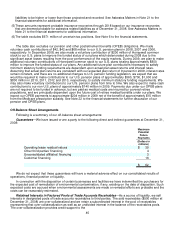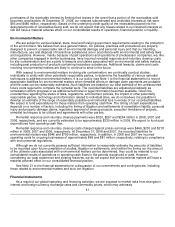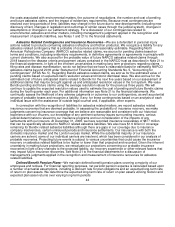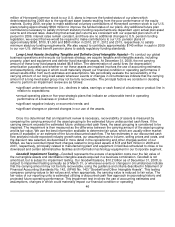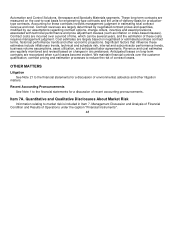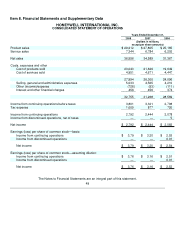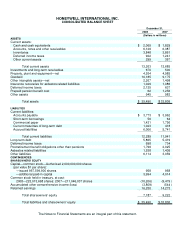Honeywell 2008 Annual Report Download - page 65
Download and view the complete annual report
Please find page 65 of the 2008 Honeywell annual report below. You can navigate through the pages in the report by either clicking on the pages listed below, or by using the keyword search tool below to find specific information within the annual report.
million of Honeywell common stock to our U.S. plans to improve the funded status of our plans which
deteriorated during 2008 due to the significant asset losses resulting from the poor performance of the equity
markets. During 2009, we plan to make additional voluntary contributions of Honeywell common stock to our U.S.
plans totaling approximately $800 million to improve the funded status of our plans. Any additional future plan
contributions necessary to satisfy minimum statutory funding requirements are dependent upon actual plan asset
returns and interest rates. Assuming that actual plan returns are consistent with our expected plan return of 9
percent in 2009, interest rates remain constant, and there are no additional changes to U.S. pension funding
legislation, we expect that we would be required to make contributions to our U.S. pension plans of
approximately $360, $700, $1,000 and $800 million in 2010, 2011, 2012 and 2013, respectively, to satisfy
minimum statutory funding requirements. We also expect to contribute approximately $140 million in cash in 2009
to our non-U.S. defined benefit pension plans to satisfy regulatory funding standards.
Long-Lived Assets (including Tangible and Definite-Lived Intangible Assets)—To conduct our global
business operations and execute our business strategy, we acquire tangible and intangible assets, including
property, plant and equipment and definite-lived intangible assets. At December 31, 2008, the net carrying
amount of these long-lived assets totaled $6.8 billion. The determination of useful lives (for depreciation/
amortization purposes) and whether or not these assets are impaired involves the use of accounting estimates
and assumptions, changes in which could materially impact our financial condition or operating performance if
actual results differ from such estimates and assumptions. We periodically evaluate the recoverability of the
carrying amount of our long-lived assets whenever events or changes in circumstances indicate that the carrying
amount of a long-lived asset group may not be fully recoverable. The principal factors we consider in deciding
when to perform an impairment review are as follows:
• significant under-performance (i.e., declines in sales, earnings or cash flows) of a business or product line in
relation to expectations;
•
annual operating plans or five-year strategic plans that indicate an unfavorable trend in operating
performance of a business or product line;
•
significant negative industry or economic trends; and
•
significant changes or planned changes in our use of the assets.
Once it is determined that an impairment review is necessary, recoverability of assets is measured by
comparing the carrying amount of the asset grouping to the estimated future undiscounted cash flows. If the
carrying amount exceeds the estimated future undiscounted cash flows, the asset grouping is considered to be
impaired. The impairment is then measured as the difference between the carrying amount of the asset grouping
and its fair value. We use the best information available to determine fair value, which are usually either market
prices (if available) or an estimate of the future discounted cash flow. The key estimates in our discounted cash
flow analysis include expected industry growth rates, our assumptions as to volume, selling prices and costs, and
the discount rate selected. As described in more detail in the repositioning and other charges section of our
MD&A, we have recorded impairment charges related to long-lived assets of $78 and $23 million in 2008 and
2007, respectively, principally related to manufacturing plant and equipment in facilities scheduled to close or be
downsized and certain administrative facilities and information technology equipment in our Corporate segment.
Goodwill Impairment Testing—Goodwill represents the excess of acquisition costs over the fair value of
the net tangible assets and identifiable intangible assets acquired in a business combination. Goodwill is not
amortized, but is subject to impairment testing. Our Goodwill balance, $10.2 billion as of December 31, 2008, is
subject to impairment testing annually as of March 31, or whenever events or changes in circumstances indicate
that the carrying amount may not be fully recoverable, using the guidance and criteria described in Statement of
Financial Accounting Standards No. 142, (SFAS No. 142) "Goodwill and Other Intangible Assets". This testing
compares carrying values to fair values and, when appropriate, the carrying value is reduced to fair value. The
fair value of our reporting units is estimated utilizing a discounted cash flow approach incorporating historic and
projected future operating performance. This impairment test involves the use of accounting estimates and
assumptions, changes in which could materially impact our financial condition or operating
46




